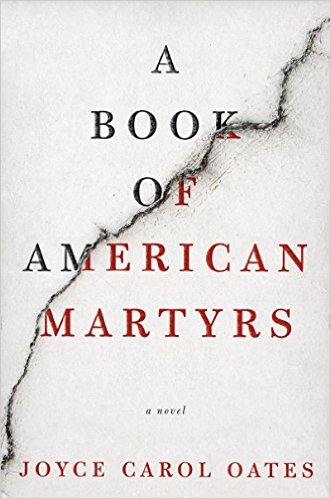A Book of American Martyrs
by Joyce Carol Oates
reviewed by Okla Elliott
A Book of American Martyrs is at once a family drama, a legal thriller, and a political autopsy of the United States. As its title suggests, this new novel by Joyce Carol Oates is utterly American—and it is essential reading at this point in our country’s history. Oates’s renowned literary powers and well-known obsessions—violence, gender relations, and American politics—are on full display in her latest work.
The novel opens with an anti-abortion activist killing an abortion provider and his assistant with a shotgun, an action that is painstakingly described over the course of five viscerally real pages. Oates excavates American culture to show how it is conditioned by economic and political forces, thereby revealing the underlying causal connections between the personal and the political.
There are dozens of striking passages throughout A Book of American Martyrs, and the prose is excellent and eminently readable, but what most impresses craft-wise is the novel’s structure. The first structural aspect readers will notice is its temporal disjointedness. Between and within sections, Oates jumps back and forth from the present action to a backstory layered like tectonic plates whose shifting frictions have led to the present disasters. There are also occasional uses of prolepsis, giving us glimpses into future consequences of events and the decisions that caused them. The novel deals with various traumas: the initial violent event of the novel, a car accident, abandonment, a rape, and myriad less severe experiences of violence. One psychological effect of trauma on sufferers is temporal confusion and narrative disorientation, so the disjointed temporal structure of the novel is fitting. Memory and its fallibility, especially under traumatic duress, are a constant theme in the novel.
There are also several wisely imprecise mirrorings between the families of the abortion provider and his murderer. Oates avoids the overly neat parallels a lesser writer might be tempted by, choosing instead similarities between them that show a common humanity while admitting notable differences. The parents in both families are ideologically entrenched in radically different ways that end up harming their marriages and their children; the children both accept and rebel against their parents’ beliefs, but idiosyncratically so. All the normal human suffering that befalls mortals does all its normal damage in both families, but here again in notably different ways.
Another area where Oates excels is the admirable level of empathy she exhibits for such a wide range of characters. There have been several studies that prove reading literature increases one’s empathy, particularly for those different from us culturally, demographically, or ideologically. A Book of American Martyrs stretches readers’ empathy in many directions because of the range of psyches depicted with such detailed interiority. Perhaps the most impressive feat of empathetic depiction is embodied in the character of Luther Dunphy, the aforementioned anti-abortion activist who opens the novel with a double murder. By a feat of literary sorcery, Oates makes us want to spend more time with this character, makes us even like him and not just sympathize but actually empathize with him in many ways.
The theme of empathy plays out within the narrative, as we watch the characters exhibit various degrees of empathy or lack thereof. The liberal pro-abortion characters and the fundamentalist anti-abortion characters use the terms “the enemy” and “enemies” to describe their opponents, a means on both sides to reduce and dehumanize the other.
It should also be noted that Oates handles the courtroom and other legal aspects of the narrative deftly. She, in effect, puts American political and religious thought on trial, yet she avoids proselytizing for either side. She achieves this by couching these aspects in the visceral human experience of the trial and of dealing with the legal system instead of resorting to easy abstraction.
The novel ends on a slightly positive note, with the daughter of the murderer and the daughter of the victim finding a tentative reconciliation years after the violent event that sets the novel in motion. We don’t see the results of their attempt at healing the wounds between them, but the possibility of members of “enemy” camps coming together after a traumatic event is presented, and we get the sense that they will make the most of that possibility. The novel therefore, despite the many traumas it depicts and all the human failings it exposes, ends on the possibility of a better future for these two characters and for the nation as a whole.
In the final analysis, A Book of American Martyrs is an accessible literary novel that synthesizes many of the key cultural and political issues of our time through a remarkable range of fully developed characters.
Published on February 21, 2017

